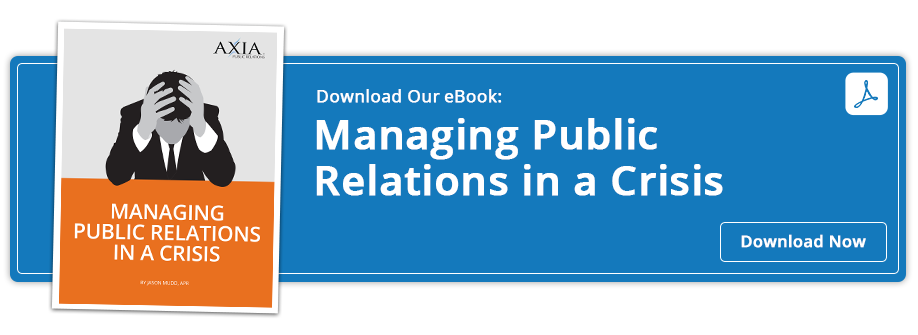 Sometimes it’s what you don’t do that matters
Sometimes it’s what you don’t do that matters
Business icon Henry Ford said, “Failure is simply the opportunity to begin again, this time more intelligently.” With that in mind, Axia Public Relations once again brings you the top avoidable PR goofs of the year. Let’s hope no one repeats the errors of 2016 next year.
No matter how bad your year was, hopefully, you can take comfort in the fact that you didn’t suffer a reputation-destroying PR goof. Here are five PR mistakes you can avoid making in the future.
Goof #1: The Wounded Warrior Project
The organization created to help injured servicemen and servicewomen found itself in hot water over its spending habits using donated money. Research found that they spent only 60 percent of donations on the veterans. Some of the offending behavior included $26 million spent on staff meetings and conferences.
When the public most wanted to hear from CEO Steven Nardizzi, he was nowhere to be found. Instead, the organization used its director of alumni as a spokesperson. The board of directors eventually fired Nardizzi and COO Al Giordano.
What you should do instead: Choose the right spokesperson and make sure he or she is properly trained to handle media inquiries.
Goof # 2: Microsoft
The computer software behemoth created a “chatterbot” called Tay to test out its artificial intelligence software. Microsoft designed Tay as an experiment in “conversational understanding.” The idea was that the more people chatted with it, the smarter it would get, as it learned to engage in fun, playful conversation on Twitter.
Unfortunately for Microsoft, the only thing users managed to teach the bot was how to be racist, sexist and anti-Semitic. In what appeared to be a coordinated effort, troublemaking trolls seemed to quickly take over and had the bot repeating undesirable viewpoints and language with the simple “repeat after me” phrase. Techs tried to delete the malicious Tweets, but were quickly overwhelmed by the sheer number. In less than 24 hours, the company was forced to take Tay offline for adjustments and it apologized for the offensive Tweets. The company received major criticism for not installing filters to prevent such a situation.
What you should do instead: Before launching a campaign, take the time to see all angles.
Goof # 3: Miracle Mattress
The Texas-based company decided to have a “Twin Towers” sale where you could get any mattress for the price of a twin on the anniversary of 9/11. Its Facebook video showed two employees scream and fall backwards into two piles of mattresses, obviously meant to symbolize the destruction of New York’s twin towers.
Backlash from the public was swift. The company removed the video and owner Mike Bonanno issued a written apology.
What you should so instead: Remember, it’s NEVER a good idea to try and capitalize on a tragedy for the sake of a sale.
Goof # 4: The Academy of Motion Picture Arts and Sciences
The group has been criticized for the past few years for its lack of diversity in nominated films and performers. In 2016, with no black nominees in any of the top categories, the public pounced, leading to a threatened boycott and the social media hashtag #OscarsSoWhite.
Academy President Cheryl Boone Isaacs responded with a statement expressing her dismay and frustration and promising dramatic changes in the makeup of its voting membership. While some did follow through on their threats of a boycott, others have taken a wait-and-see approach.
What you should do instead: Don’t ignore an impending issue. This crisis had been building for some time, and the Academy only responded in the wake of a serious boycott strategy by major actors – black and white.
Goof # 5: Razer
After Apple released its 2016 MacBook Pro without a secure digital (SD) port that many professionals use, Razer issued a Tweet at Apple that read, “You call yourself Pro? S my D.”
Razer initially tried to defend the Tweet by saying it was simply proud of its own SD card slot. The company later apologized and deleted the post.
What you should do instead: When considering using humor, don’t. Humor is best left to professionals at a PR firm.
At Axia Public Relations, we can help you create interesting messages and exciting campaigns that strike the right chord for your audience (instead of leaving a bad taste in their mouths). To avoid making this list next year, contact us or download our e-book Managing Public Relations in a Crisis.
 Lisa Goldsberry is a blogger for Axia Public Relations with more than 15 years of public relations experience. She specializes in business and technology PR. Lisa has worked for Axia since December 2013. Learn more about Lisa Goldsberry. Connect with Axia on Twitter @axiapr or tell us what you think in the comments below.
Lisa Goldsberry is a blogger for Axia Public Relations with more than 15 years of public relations experience. She specializes in business and technology PR. Lisa has worked for Axia since December 2013. Learn more about Lisa Goldsberry. Connect with Axia on Twitter @axiapr or tell us what you think in the comments below.
Featured image credit: 123rf.com
Topics: public relations, crisis communications



Comment on This Article